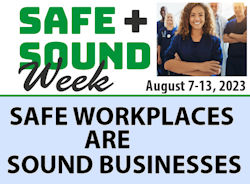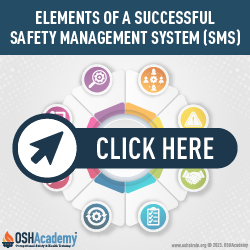Commitment and Leadership
How Management Demonstrates Commitment
Management demonstrates its commitment to continuous improvement in safety and health, communicates that commitment to workers, and sets program expectations and responsibilities.
Managers at all levels should regard safety and health as a core value, not merely a priority. They should establish safety and health goals and objectives, provide adequate resources and support for the program, and set positive examples of leadership.
The Safety Management System (SMS) is most effective when management integrates it into the company’s overall corporate management system (SMS) and deploys it to all functions and departments in the company. A world-class SMS should not be viewed as a separate function from operations.
Characteristics
The success of the SMS in achieving its goals largely depends on its characteristics. Below is a list of typical characteristics of an effective SMS.
Characteristics
- Vision: The SMS will reflect management's vision for safety that tells the world what the company believes about itself. The corporate vision influences an organization's strategic goals and objectives. A simple vision statement might say, "Our safety vision at 123 Industries is to be the benchmark for safety excellence in our industry."
- Mission: The SMS mission tells the world why it exists, its purpose, and what it does to realize its vision. For instance, a simple mission statement might say, "Our mission at 123 Industries is to achieve and maintain an injury-free workplace."
- Goals and Objectives: Goals and objectives describe the long-term strategies and short-term tactics the company uses to achieve its SMS mission and vision.
- Structure: The SMS structure is determined by how it is designed. It describes management positions and programs. The structure is usually described using an organizational chart indicating various positions such as a safety manager, line/staff managers, supervisors, and a safety committee.
- Inputs: The inputs of an effective SMS include the resources and information needed to manage safety within an organization. Staffing, funding, physical resources and psychosocial support, dedicated time, and facilities all provide the inputs needed for the SMS to perform successfully.
- Behavior: The sum total of how all individuals in an organization conduct their day-to-day safety responsibilities describes the overall behavior of the SMS. These behaviors are influenced by how people perceive the safety function and their role in it. If SMS leaders act like safety "cops" instead of safety "consultants," the SMS will primarily function as an enforcement mechanism. But a well-functioning SMS will behave in a way that is proactive, flexible, and responsive to changing safety needs.
- Performance: How well the SMS executes its programs and achieves its goals describes its performance. Performance is aligned with the knowledge, skills, and abilities (KSAs) of responsible individuals. It's guided by the quality of internal SMS policies, programs, written plans, processes, procedures, and practices.
- Outputs: The outputs of an effective SMS are the outcomes or results achieved in managing safety risks within an organization. This includes a reduction in safety incidents and injuries, improved safety performance metrics, and a culture of safety within the organization.
Interrelated Elements
How well a company's safety function performs depends to a large degree on quality of each of its elements. Below is a list of the typical elements in an effective SMS.
Elements In an SMS
- Commitment and Leadership: This involves management commitment to the safety program, including establishing safety policies and procedures, providing resources for safety initiatives, and setting a positive example for employees.
- Accountability: The SMS assures managers and employees are answerable and that appropriate consequences follow performance for maintaining a safe and healthy work environment.
- Safety Involvement: Employees are encouraged to participate in the safety program by providing input on safety policies and procedures, identifying hazards, and participating in safety training and education.
- Safety Communications: Communication and coordination are essential elements of the SMS, including regular communication with employees on safety issues, coordination with other departments or contractors, and sharing of safety-related information and data.
- Hazard Identification, Analysis, and Control: The SMS includes a process for identifying and analyzing potential safety hazards, and implementing control to eliminate or mitigate those hazards.
- Accident Investigation: The SMS conducts thorough investigations to determine the root causes of non-injury incidents and injury accidents. It develops strategies to prevent similar events from occurring in the future.
- Education and Training: The SMS provides education and training to employees on safety policies and procedures, hazard recognition, and safe work practices. The goal is to give them the necessary knowledge, skills, and abilities (KSAs) through instruction, hands-on training, and practice to work accident-free.
- Continuous Improvement: The SMS is continually evaluated and improved to ensure that it is effective in identifying and controlling hazards, and that it is meeting the needs of the organization.
Components
The SMS, its element, and the programs within each element are composed of similar functional components that work together to define the SMS. Below is a list of the typical components in an effective SMS.
The Components in Each Element
- Policies: General guidance formulated and implemented by managers at all levels.
- Programs: Describe coordinated strategies that support policy.
- Plans: Give clear written (formal) guidelines on how to implement programs and policies. Includes long-term strategies and short-term tactics.
- Processes: Make sure safety is integrated into operational processes.
- Procedures: Ensure concise formal/informal step-by-step instructions.
- Budgets: Support investment in all of the above.
- Rules: Clearly state specifications and performance standards.
- Reports: Reflect process and measures results. Evaluate the effectiveness of all the above.
- Indicators: Measurable values that demonstrate how effectively a company is achieving its goals and objectives.
OSHA has developed Recommended Practices for Safety and Health Programs for General Industry, Construction, in Spanish that will help you analyze and evaluate your organization's SMS. We encourage you to use this valuable resource.
Knowledge Check Choose the best answer for the question.
1-1. What should employers do to help ensure it's safety management system is effective?
You forgot to answer the question!


